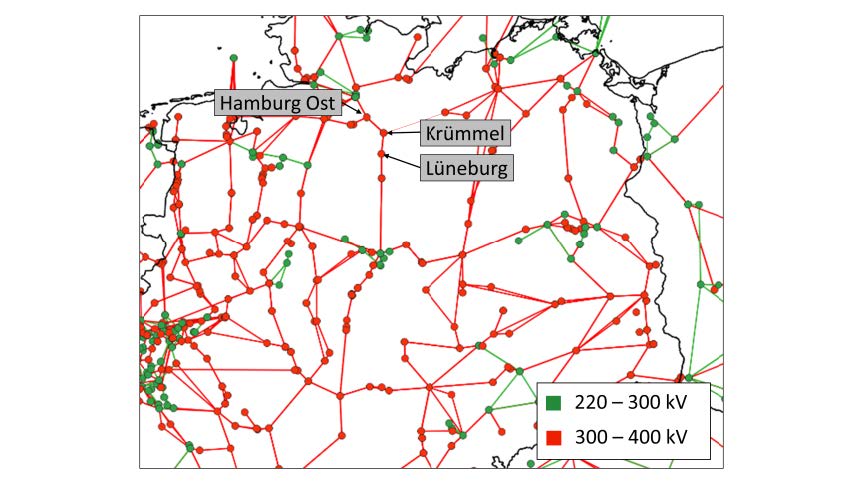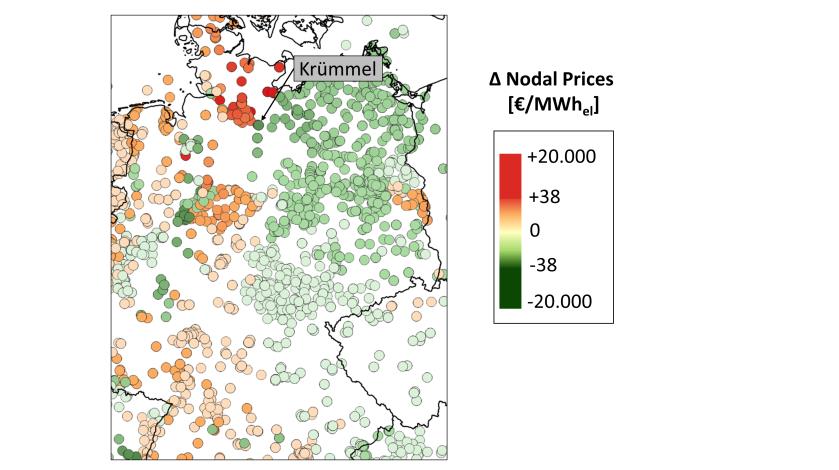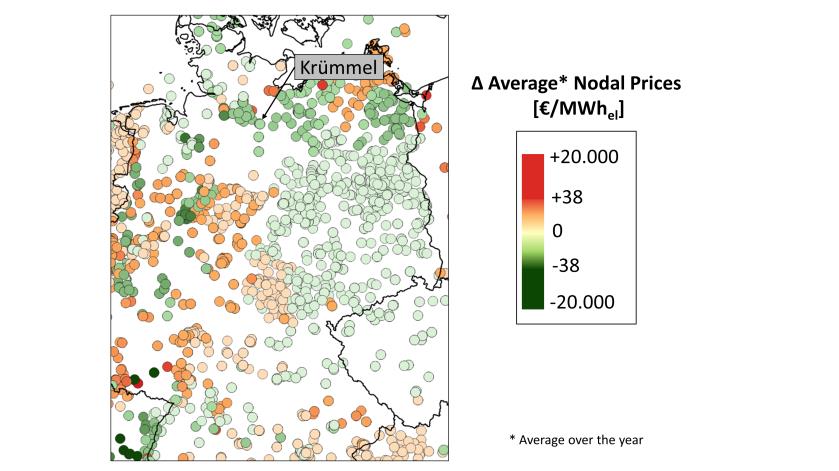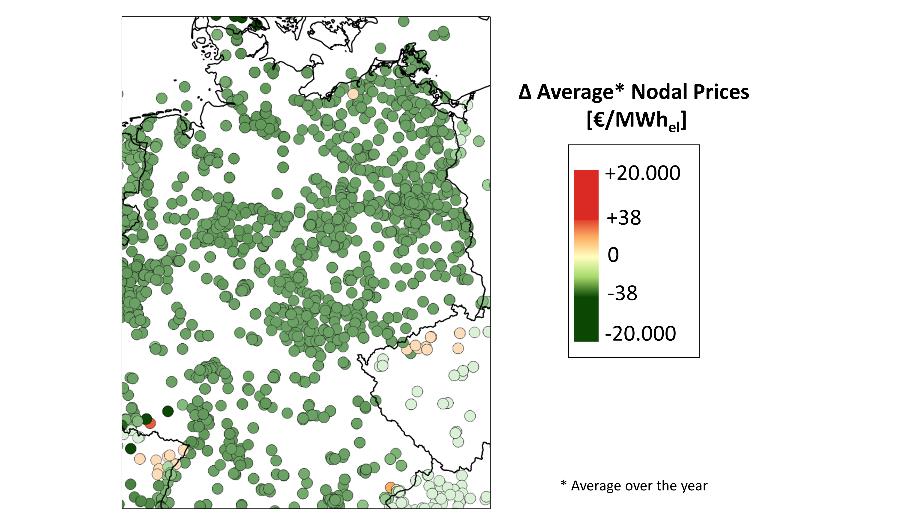Project
Investigating the impact of network topological measures and demand side management processes on nodal prices in the European power system
Due to the European zonal electricity market model, European electricity prices are often determined for an entire European country without considering a detailed European transmission network model. Node-specific electricity prices, so-called nodal prices, that require a transmission network model in high resolution, provide a valuable indication for the techno-economic optimal use of existing network infrastructure. The nodal price reflects the nodal value of electrical energy, which includes the cost of electricity production and the cost of delivering it (e.g., losses and congestion). However, the determination of these nodal prices is very complex, so the mathematical methods in use model the technical properties of the electrical assets in a simplified way. While the use of network topological measures and the dispatch of flexible electricity consumers is common in reality, their consideration in mathematical methods for determining nodal prices has been neglected so far and is very challenging in terms of complexity and calculation time. Therefore, network topological measures and flexible consumers are to integrate into existing mathematical methods for determining nodal prices to investigate their influence on nodal prices. Due to the high complexity and calculation time, which is even increasing with the raised implementations, using HPC is inevitable.
Project Details
Project term
February 2, 2022–December 3, 2022
Affiliations
RWTH Aachen University
Institute
IAEW
Project Manager
Principal Investigator
Researchers
Methods
Due to the European zonal electricity market model, European electricity prices are often determined for an entire European country without considering a detailed European transmission network model. Node-specific electricity prices, so-called nodal prices, that require a transmission network model in high resolution, provide a valuable indication for the techno-economic optimal use of existing network infrastructure. The nodal price reflects the nodal value of electrical energy, which includes the cost of electricity production and the cost of delivering it (e.g., losses and congestion). However, the determination of these nodal prices is very complex, so the mathematical methods in use model the technical properties of the electrical assets in a simplified way. While the use of network topological measures and the dispatch of flexible electricity consumers is common in reality, their consideration in mathematical methods for determining nodal prices has been neglected so far and is very challenging in terms of complexity and calculation time. Therefore, network topological measures and flexible consumers are to integrate into existing mathematical methods for determining nodal prices to investigate their influence on nodal prices. Due to the high complexity and calculation time, which is even increasing with the raised implementations, using HPC is inevitable.
Results
The investigations are based on the determination of nodal prices for a scenario for the entire future year of 2030 (created in 2019) in hourly time steps and for the European transmission network, which is modeled with reduced resolution outside the European CWE1 region. In addition to thermal and hydraulic power plants as well as curtailment of renewable energy feed-ins, the tap positions of phase shifting transformers, AC and DC lines are also considered. The newly implemented topological measures and flexible consumers can be considered optionally. Input data is based on confidential data from industry partners. The investigation program is as follows:
- “Reference”: determination of nodal prices without considering topological measures and flexible consumers
- “Sensitivity Topo”: also considering one exemplary topological measure near Hamburg for the entire year, which opens the connection from Krümmel to Hamburg and closes the connection from Krümmel to Lüneburg, cf. figure 1 (no flexible consumers)
- “Sensitivity Flex”: also considering flexible consumers for the entire year, which are distributed over Germany (no topological measures)
- A comparison of these runs serves for testing the extended mathematical methods and provides first evidence of the influence of the topological measure and the flexible consumers on nodal prices.
Discussion
The influence of the topological measure on nodal prices is significant and comprehensible when examining single situations, i.e. single hours. When the power flows near Hamburg are from east to west, the topological measure results in lower nodal prices for almost complete East Germany while higher nodal prices appear from Hamburg down to Höxter (cf. figure 2). This region is known to be often congested. When the flows are from west to east, nodal prices mainly increase over Germany. As a result, the nodal prices are influenced on average over the year as shown in figure 3. The deltas (nodal prices “Sensitivity Topo” minus nodal prices “Reference”) at maximum, 99%-, 90%-, 50%-, 10%-, and 1%-quantile as well as at minimum for individual German transmission nodes are as follows: 417, 18, 5, -0.5, -7, -25, -222 €/MWhel.
The influence of the distributed flexible consumers on nodal prices is regionally comparable and lowers the nodal prices for almost all German transmission nodes. Therefore, the node-specific influence is less significant in comparison to the topological measure (cf. Figure 4). The deltas (nodal prices “Sensitivity Flex” minus nodal prices “Reference”) at maximum, 99%-, 90%-, 50%-, 10%-, and 1%-quantile as well as at minimum for individual German transmission nodes are as follows: 23, -8, -17, -18, -18, -21, -86 €/MWhel.
To sum up, both the topological measure and flexible consumers show significant influence on nodal prices. While the topological measure both increases and lowers the nodal prices regionally and nearly equally, the prices generally decrease when considering flexible consumers. Furthermore, the changes in nodal prices are extreme with the topological measure.
Future work could investigate the influence on a European level. Furthermore, multiple and time-specific topological measures could be considered to represent the transmission network operation more realistically.
Additional Project Information
DFG classification: 408-03 Electrical Energy Generation, Distribution, Application
Software: Matlab, Gurobi Optimization
Cluster: CLAIX
 Location of topological measure in the transmission network.
Location of topological measure in the transmission network.  Influence of topological measure on nodal prices in Germany for one exemplary hour (high East-West power flow).
Influence of topological measure on nodal prices in Germany for one exemplary hour (high East-West power flow).  Average influence of topological measure on nodal prices in Germany (Average over the year).
Average influence of topological measure on nodal prices in Germany (Average over the year).  Average influence of flexible consumers on nodal prices in Germany (Average over the year).
Average influence of flexible consumers on nodal prices in Germany (Average over the year).